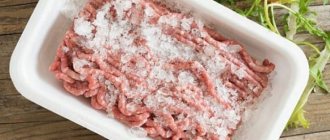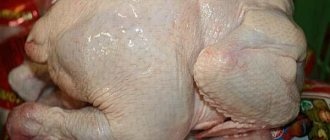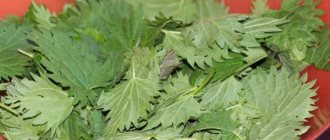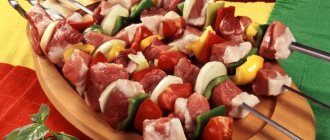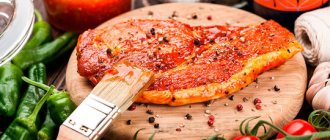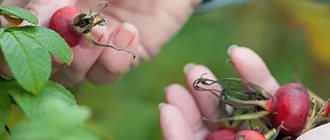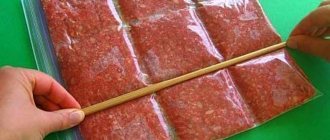Compared to canning and pickling, freezing meat to extend its shelf life has a number of advantages, such as: minimal preparation, long-term preservation of quality, ease of storage, prevention of bacteriological hazards and the ability to control the condition of meat during freezing. A product can be considered frozen if its center temperature is -15°C or lower.
What happens to meat after secondary freezing?
Refreezing meat can be done safely, but it can often affect the quality of the product. For example, freezing and thawing more than once can result in changes in odor, color, loss of moisture, and increased oxidation of protein and fat. Oxidation is a process in which electrons are transferred from one atom to another. When this process occurs with meat, it can lead to significant deterioration in quality. Any changes in the meat's ability to retain moisture can also significantly affect its tenderness and juiciness.
“Loneliness is not a problem”: Marina Fedunkiv about her previous experience of marriage
Youth returned: Irina Dubtsova surprised subscribers with a younger face
X-rays helped scientists “see” schizophrenia
Experts say that in some cases, refrigerated storage and freezing of meat more than once can have a positive effect on tenderness. However, the type of meat, as well as the exact number of freeze-thaw cycles it goes through, influence how the cut will react to being re-frozen.
Freezing in liquid medium
Freezing in a liquid medium as applied to meat is carried out in the form of freezing in brine by the contact freezing method, when the product is in direct contact with the brine, and by the indirect contact freezing method, when the product is enclosed in shells, forms in contact with the brine.
The process of freezing meat in a liquid medium, from the point of view of its acceleration, is more rational than in air, but within certain limits of the thickness of the frozen meat products.
Contact freezing
There are two methods: immersion freezing and irrigation freezing. A solution of table salt is used as a freezing medium in the contact method. The use of solutions of salts such as calcium chloride or magnesium is unacceptable due to imparting a bitter taste to the meat and spoiling it as a food product. Both contact freezing methods - immersion and irrigation - have, along with great advantages - speeding up the process and the absence of weight losses - two main disadvantages:
- penetration of salt onto the surface and inside the product to a certain depth due to the difference in osmotic pressure of solutions and
- color change that impairs the external commercial qualities of the product.
In 1912, Ottesen proposed a method of contact freezing of a product in brine, based on the use of the freezing properties of solutions at different temperatures and concentrations.
The state of solutions on the freezing and saturation curves is characterized by the equilibrium between the liquid and solid phases of the solution. The saturated solution, cooled to the cryoscopic point, releases pure ice. If you add water or immerse ice in such a solution, they will not be absorbed by the solution. If a product is immersed in such a saturated solution that releases ice, then the solution is not able to absorb moisture from the product and give it salt: exchange diffusion does not occur in it, based on the difference in osmotic pressure, such a salt solution is indifferent to the one immersed in him to the product.
When the brine state deviates from the cryoscopic point, salting of the product will occur.
The main reason for the inability to eliminate the penetration of salt into the product is the temperature difference between the product and the solution that is completely inevitable during freezing.
At the surface of the frozen product, the brine will always be warmer than the surrounding one, even if the average temperature of its entire mass corresponds to the cryoscopic point. Consequently, osmotic penetration of salt into the product will occur throughout the entire freezing period. Ottesen's theoretical foundations remain unfulfilled in practice.
Due to the practical impossibility of maintaining the state of the brine at the cryoscopic freezing point, it becomes necessary to first cool the product before immersing it in the brine, and also add special substances to the brine, such as glycerin, and every 5% of glycerin allows the freezing point to be lowered by 1° below the cryoscopic point of the brine. The disadvantage of using glycerin is that the product acquires a sweetish taste; a thin layer of brine still remains on the surface, which during storage can lead to a change in the color of the product (darkening of the meat).
The amount and rate of penetration of salt into the tissue depend not only on the freezing point of the brine, but on the nature of the muscle tissue, freshness and grade, as well as on the fat content of the subcutaneous muscles. A thick layer of fat on the surface of meat (such as pork) can almost completely prevent salt penetration.
Adding various ingredients to the brine that help preserve the color of frozen meat does not give good results: after a certain period of storage, the meat darkens and sometimes turns brown.
The Pacific Fisheries Station in British Columbia has proposed a method of maintaining a constant temperature of the cooling solution by pre-freezing ice on the brine cooling coils. This technique prevents salt from penetrating into the product, but it is labor-intensive and technically complex.
The freezing period using the contact method for meat carcasses and half-carcasses of average fatness at a brine temperature ranging from -21.1° eutectic solution to -23-25° is 6-8 hours.
Contact freezing by irrigation with brine, first proposed for fish, was slightly modified for meat by M. T. Zarochentsev, and it is mainly used for freezing pork and lamb. The process is divided into three phases: in the first phase, the meat is pre-washed in the shower; in the second phase, the product is frozen in a medium of brine finely sprayed by nozzles; in the third phase, the capillary layer of brine that has settled on the food is washed off under the shower. The first phase is not necessary if the product has a well prepared and clean surface.
Brine for freezing is served at a temperature of -16°. Spraying the brine, promoting its evaporation, increases heat transfer. The process of contact freezing by irrigation is still slower than with the immersion freezing method. At the same temperature of the cooling brine, the period of freezing by irrigation is extended compared to the period of freezing by immersion by approximately 50%. Practically as a result of the above, the direct contact method of freezing meat has not been used.
Contactless freezing
(in shells) avoids the disadvantages of contact freezing. In this case, salts with a cryoscopic point lower than that of sodium chloride (calcium chloride, magnesium chloride, etc.) can be used in solutions.
When covering food with protective casings before freezing, it is necessary to ensure maximum removal of air from the space between the surface of the meat and the casing.
Experiments on freezing carcasses and half-carcasses of meat in casings were carried out by D. A. Christodoulo in 1933-1934. and in 1952, and rubber bandages were used as a shell. You can also use bandages made of rubberized gauze, cellophane, or vinyl chloride film. The carcass or half of the carcass is tightly wrapped in a bandage from bottom to top so that each wrap is on the edge of the underlying one to prevent brine from getting under the wrapper.
At brine temperatures of -47, -22, -27°, a chilled half-carcass of beef weighing 90 kg with irrigation of 0.329 l/kg min was frozen to -8° for 16.4; 12 and 9 o'clock; chilled lamb carcasses weighing 12-16 kg - at a brine temperature of -17° for 6-9 hours, and chilled pork half-carcasses weighing 18-28 kg - for 10-12 hours, weighing 40-45 kg - for 16- 6 p.m. with an average brine consumption of 0.251 l/kg min. Weight loss was expressed in the range of only 0.1-0.12%.
The marketability of meat frozen in protective casings is almost no different from meat frozen in air. The disadvantage of freezing in shells is the laboriousness of putting on bags or bandages and suctioning out the air. Meat frozen in bags or bandages can be stored in the same casings, which improves sanitary storage conditions and reduces freezing losses.
Freezing cuts, blocks of meat and offal in metal forms by immersion in brine or irrigation requires significantly less time compared to air freezing. Compared to contact freezing, due to the difficulty of achieving, especially for cuts, a tight fit of the product to the walls of the mold, the freezing process (in molds) proceeds more slowly. To speed up the process, it is necessary to resort to a significant decrease in the temperature of the brine.
Beef
Studies have shown that various freeze-thaw combinations reduced the size of beef steak when cooked. The researchers also found that the combination of freezing, thawing and aging the steaks increased the tenderness of the meat compared to fresh steaks that were aged but not frozen. In addition, research has found that the less time meat is re-used in the freezer, the less negative effects there will be on the quality of the product.
The importance of safe meat storage
Safe storage can protect meat from loss of quality and flavor, as well as bacterial growth.
The United States Department of Agriculture (USDA) notes that storing meat safely in a freezer at -18°C lowers the temperature to a point that inhibits the growth of most bacteria ().
Higher temperatures can allow bacteria to grow on the meat, which can cause illness. This is why meat usually only lasts for a few days in the refrigerator. Cooler temperatures may slow the growth of some bacteria, but this is not enough to prevent food from spoiling.
Proper freezing also protects against pathogenic bacteria that cause foodborne illness and food poisoning ().
Reliable storage also protects meat from loss of taste and quality. A number of compounds in meat oxidize and break down fairly quickly at room temperature, which can lead to a noticeable loss of flavor.
Proper storage methods such as drying, smoking and freezing can help slow this process or prevent partial or complete loss of quality.
Mutton
Australian scientists conducted an experiment on lamb meat. They found that freezing and storing meat at different temperatures affected quality factors such as juiciness, texture and shrinkage. Lamb stored at deep-frozen temperatures between -50 °C and -80 °C remained more tender after thawing compared to meat stored at the normal freezing temperature of -18 °C.
The greatest value in the house is peace: how to save a family (advice from a hieromonk)
10 of the cutest reunions between dogs and their owners: photos that can touch you
Planetary alignment in March 2021: good and bad dates for all zodiac signs
What GOST and SanPiN say
Technologies for raising livestock do not stand still. The producer does not want to graze animals on pastures and fatten them for 1–1.5 years. Everyone wants quick results. The introduction of synthetic amino acids into the diet of animals affects their growth rate and the quality of meat.
GOST no longer undertakes to establish storage periods and conditions. Everything is left to the discretion of the manufacturer. However, GOST regulates recommended deadlines that cannot be exceeded.
The recommended shelf life of chilled meat (beef) packaged under vacuum at a temperature of -1 to 4 °C and a humidity of 85% is no more than 25 days from the date of slaughter. This period includes the ripening period of the product, which is at least 5 days.
Other periods and conditions are indicated in the table:
Conditions and terms of storage of raw meat according to GOST
When meat enters an enterprise that produces or sells perishable products, SanPiN comes into force. It regulates storage conditions at a temperature not exceeding 6 °C (as in a household refrigerator).
In this case, the storage periods will be as follows:
Shelf life of raw meat, semi-finished products and ready-made meat dishes according to SanPiN. Click on the image to enlarge (opens in a new window)
Do you know that…
Strict requirements are imposed on finished meat products. The microflora in such products develops very quickly. Storage periods are set in hours, no more.
Pork
A loin is a piece of meat cut from the chest of a pig. Two recent studies examined the effects of freezing and thawing on pork. The first study compared three freeze-thaw sequences. Each step resulted in more discoloration of the meat, but the researchers also found that aging pork by freezing it could be an effective way to keep the meat tender. A second study shows that freezing and then thawing pork loin once does not have a significant effect on the tenderness of the meat. On the other hand, the juiciness of meat may decrease after repeated freezing and thawing.
Poultry meat
A study by Turkish scientists conducted among 384 supermarket shoppers showed that the most common ways to defrost chicken are:
Stress and overeating: the doctor explained why you have nightmares
Georgia opens border to Russians, but there are rules for visiting it
Five male zodiac signs whose representatives many women like
- fridge;
- microwave;
- warm water;
- tap water;
- tabletop.
The researchers determined that none of these thawing methods had a significant effect on the color or texture of poultry meat. However, thawing in the refrigerator or microwave resulted in approximately 18% less shrinkage during cooking compared to other thawing methods.
However, additional research has shown that the more times chicken is frozen and thawed, the more likely you are to experience a change in color and juiciness. Therefore, when freezing poultry meat a second time, remember that this procedure can affect the quality of the product by changing its smell, color, juiciness and tenderness, as well as its degree of shrinkage during cooking.
Freezing vegetables, fruits and mushrooms
Is it possible to freeze mushrooms?
Yes, this can be done with any mushrooms: wild mushrooms, fresh store-bought champignons, honey mushrooms and others. But, if store-bought champignons and oyster mushrooms can be put in the freezer raw, then forest mushrooms must be boiled for five minutes first.
Interesting: Storing Carrots in the Cellar at Home
To prevent the mushrooms in the bag from sticking together, after slicing or cooking, they must be laid out on a waffle towel and dried a little. And only after that place it in portioned bags.
Should you freeze berries?
Of course it's worth it! Any berry after freezing loses a little taste, of course.
It becomes a little watery and sour. But on the other hand, it retains much more vitamins than in a jar of jam.
Berries need to be frozen in two stages. The first time they need to be laid out on a board and slightly frozen, and when they “set” a little, put them into portioned bags and finally freeze.
Vegetables
Many, but not all, tolerate freezing well. Let's figure out which vegetables can be frozen for the winter at home, and which are undesirable.
By and large, you can freeze everything, but not all vegetables retain their taste. For example, zucchini absolutely cannot stand being frozen in slices. Whether they are fresh or blanched, they turn out rubbery and inedible.
So, what should you not put in the freezer?
- Zucchini slices (terrible consistency)
- Fresh eggplants (smell unpleasant)
- Whole tomatoes (smell unpleasant and turn to mush)
- Whole cucumbers (only water remains)
- Radish (the smell is terrible)
- Radish (same thing)
- Green salad (spreads into pieces)
Here’s what you should definitely freeze, but be sure to follow the packing and preparation tips:
- Zucchini, grated for pancakes (squeeze thoroughly first)
- Baked eggplant (for caviar)
- Grated tomatoes for borscht (pour into serving glasses)
- Cucumber juice in ice containers (for masks)
- Bell pepper (raw, either pieces or whole)
- Peeled garlic
- Grated beets and carrots
- Regular beans (keeps well and no bugs)
- Green beans (need to be blanched)
- Sorrel (raw, chopped)
This is the most necessary set. But besides this, it is quite possible to freeze pumpkin pieces, potatoes, cabbage and even green onions!
Some people don't really like the taste of frozen potatoes, because it makes them a little sweeter. But this does not stop supermarkets from selling it all year round!
Ways to Defrost Meat Safely
For best results, you should completely defrost the meat before cooking it. There are three different methods that can be used to safely defrost meat:
- Defrosting in the refrigerator. This is the longest method, because the process can take from 1 to 7 days depending on the size. Remember that once completely defrosted, the product must be cooked within 3 days.
- Defrosting with cold water. This is a method of rapid thawing in which the meat is placed in a plastic bag and kept under cool running water. A piece thawed in this way should be cooked immediately.
- Defrosting in the microwave. Food thawed in the microwave should be cooked immediately as the defrosting process can significantly increase the temperature of some areas of the meat.
Remember, if there is even a slight chance that you will later want to freeze some or all of the meat, be sure to use the refrigerator defrost method. Meat thawed under cold water or in the microwave should be cooked immediately. To ensure safety, meat should never be frozen after thawing using cold water or the microwave.
Freezing meat in air
Freezing meat in air is the oldest and still the most common method. Heat is removed from the meat product with this freezing method by means of air washing it, cooled directly by a refrigerant or brine. The air is cooled entirely in the chambers by batteries placed in them with direct evaporation of the refrigerant or with brine, or partly by batteries and partly by air coolers located outside or inside the chambers, or completely by air coolers.
Air freezing also includes a method of freezing using outside air entering in the winter season.
If air circulation occurs naturally, the freezing time is usually very long. This type of freezing is called “silent” freezing. Acceleration of the air freezing process and a more uniform temperature distribution in the chamber is achieved by artificial air circulation, carried out by fans either by supplying air from air coolers, or installed in the chamber as chatterbox circulators. Such air cooling when air moves at a speed of about 2-5 m/sec and higher is called intensive.
The process of air freezing of meat carcasses and half-carcasses, depending on the temperature in the chamber and air circulation conditions, as well as the size and fatness of the carcasses, lasts 24-32 hours (VNIHI method - N. I. Kulbin - with artificial circulation at a temperature in the chamber -23 °) , 2 days (with natural circulation and a temperature in the chamber of -23°) and up to 4 days at a temperature of -8, -12°.
Such freezing regimes are relatively slow and are accompanied by unfavorable conditions for crystal formation with all the ensuing consequences. VNIKHI has installed a chamber with an air temperature of -66° for freezing various products, including meat products. The freezing process is reduced to several hours.
Gipromyaso designs the freezing of meat carcasses and half-carcasses in intensive chambers with a temperature of -35°.
Abroad - in the USA, England, Sweden, East Germany and Germany, Denmark - the temperature in meat freezing chambers has been maintained at -35-55° in recent years. The duration of freezing under these regimes is 24 hours for carcasses and half-carcasses of cattle and pigs.
The temperature of the medium is of great importance in accelerating the freezing process, since the rate of heat transfer is proportional to the temperature difference between the product and the cooling medium. Therefore, when air freezing, the temperature should be maintained as low as possible throughout the entire freezing process. A constant freezing temperature is established only towards the end of the process.
Immediately after loading, the temperature in the freezing chamber rises sharply due to intense heat transfer of the product to the air, which continues until the entire system comes into equilibrium and the rate of heat transfer by the product is equal to the rate of heat absorption by the refrigerant in the refrigeration system of the freezer.
As the product freezes, the rate of heat transfer decreases, but cooling continues until a small difference is established between the chamber temperature and the coolant temperature, corresponding to the conditions of thermal resistance of the cold-transfer surfaces.
Air circulation speeds up freezing, but affects the amount of weight loss of the product (shrinkage) depending on the duration of freezing. Therefore, at low freezing temperatures (air temperature below -23°) with pipe cooling, when the influence of circulation on the nature of crystal formation is small, air circulation in the chambers is often excluded, since in this case it is usually possible to reduce weight loss, excessive drying of the surface and volatilization of aromatic substances from the product.
Due to the accumulation of vapors and gases during freezing, it is necessary to ventilate the chambers at a rate of approximately 1-2 volumes per day. Ventilation is carried out using air coolers, if any. Otherwise, the chambers are ventilated by opening the doors.
The relative air humidity in the freezing chambers, based on the need to reduce losses due to freezing, is maintained at a level of 85 to 90-92%.
In recent years, accelerated freezing using air as a coolant has become increasingly widespread. The product is frozen in tunnel freezers or in special quick-freezers. The air in them moves quickly and has a low temperature and high relative humidity, and in quick-freezers, products are placed on baking sheets or conveyor belts in a layer of small height or small pieces are suspended.
In such air quick-freezers, meat in small cuts and in blocks, endocrine raw materials, offal and other meat products can be quickly frozen; in tunnels - carcasses and half-carcasses.
In an air-cooled quick-freezer designed by VNIHI (Sh. N. Kobulashvili), the duration of freezing at a circulating air temperature of -50-60° and its movement speed of 5-6 m/sec is, depending on the thickness of the meat product, from 30 minutes. until 4 o'clock
The duration of freezing meat and meat products at a temperature of -18° at a temperature of 20° in an apparatus whose air temperature is -30-32° is from 7 (meat blocks 150 mm thick) to 12 hours. (beef quarters weighing up to 44 kg).
Air freezers of a number of systems operate with air conditions: from a temperature of -25° and a speed of 2.5 m/sec to an air temperature of -55° at a speed of up to 10 m/sec. In terms of freezing time, such devices compete with devices in which the coolant is a liquid medium - brine, or with indirect contact plate devices.
Cand. tech. Sciences A.P. Sheffer proposed to intensify the freezing process using ejector air coolers, in which the heat transfer of the cooling elements is 2.5-3 times higher than that of conventional batteries.
Ejector air coolers are a system of pipelines with coolant (directly evaporating refrigerants or brine), intensively blown with air from ejectors into which it is forced by fans. The speed of air release from the ejectors is assumed to be within 20-30 m/sec. The duration of the freezing process for half-carcasses with an average weight of 70 kg at an air temperature of -18° with ejector air coolers is about 40 hours.
When freezing in air, natural or artificial shells are used to reduce the size of the freeze and preserve the commercial qualities of the product. Thus, calf carcasses (containing a lot of moisture) are frozen in the skin or in special sheets, game carcasses are frozen in the plumage. Individual cuts of meat carcasses and especially small packaged meat are frozen in a shell made of natural, artificial and synthetic materials - parchment, cellophane, various types of packaging paper, aluminum foil, polyethylene, polyvinyl chloride, etc. Such freezing is of great importance for further frozen storage form. Glazing of a frozen product is used, which gives very good results in terms of greater durability of the product, reduction of weight losses and preservation of product quality, for example, glazing of game, glazing of lard (VNIIMP experiments).
Air freezing requires proper control of temperature, humidity, and air speed to ensure the process is successful. When freezing meat in the air, it is of great importance to correctly hang carcasses and half-carcasses on overhead tracks, lay out cuts and blocks on baking sheets and hangers or directly on coils with refrigerant and completely wash them with air, as well as uniform distribution of air flows of cold air coming from air coolers, and proper suction of heated air.
conclusions
Meat is often frozen to extend shelf life and keep the product safe in cases where it cannot be consumed immediately. As long as the meat is stored properly and defrosted slowly in the refrigerator, it can be safely frozen several times.
If thawing is done correctly, freezing meat does not pose a health hazard. But we should not forget that depending on the type of meat and the number of defrostings, its quality may deteriorate significantly. If, when taking meat out of the freezer, you are not entirely sure that you will start cooking it immediately after defrosting or plan to re-freeze some of it, then be sure to use the thawing method using the refrigerator.
Found a violation? Report content
How to store raw food: terms, conditions, packaging
The refrigerator is a wonderful invention. However, this kitchen unit is young, and people have previously tried to preserve the product for as long as possible.
In the old days, salt and herbs and nettles were used as preservatives. However, nothing can compare to the cold
Interesting fact
You can store meat without a refrigerator, but only during its ripening period. Further, above-zero temperatures promote the proliferation of microflora and spoilage of the product.
How to prepare (does it need to be washed)
Meat brought from the market or store should not be washed. It is better to do this before cooking.
If you plan to cook the meat within 1-2 days, place it in a bag or container and place it in the refrigerator. If there is more product than needed, it is better to put it in the freezer.
In a refrigerator
The refrigerator is the only place for safe storage. The bottom shelf is best suited for this purpose. If you know exactly when livestock or, for example, a rabbit was slaughtered, then the storage period is determined from the moment of slaughter. This meat can be stored for 4–5 days.
If the moment of slaughter is unknown (the sticker on the package cannot always be trusted), then it is better not to store it for longer than 1–2 days.
In the freezer
Although there are shelf life limits for frozen meat, it is theoretically possible to store the product until defrosted. This is how strategic reserves are created for years. However, the longer meat sits in the freezer, the more tasteless it will be after defrosting and cooking.
Fresh meat should not be frozen. After slaughter, it is better to let it ripen and rest in the refrigerator for 1–2 days. Next, pack it in paper, a bag or container and put it in the freezer.
Note to the hostess
You can also freeze semi-finished products. Cut the piece into pieces, beat it, wrap it in portions and put it in the freezer.
After defrosting
It is better to defrost meat gradually. It needs to be removed from the chamber and moved to the refrigerator, where it can be stored for another day after complete defrosting until processing. Or put it in cold water.
But repeated freezing is unacceptable.
Without a refrigerator, on the road
Now there are thermal bags and thermal bags. If you don’t have such devices, you can use ice:
- Plastic bottles of water are frozen and placed in a container along with the meat.
- Then everything is well packaged.
Such storage is possible until the ice melts and the water begins to heat up. If the road is long, don’t take risks.
We recommend reading: Food thermal bags: 5 uses you didn’t know about.
[flat_ab id=”42"] [f[flat_ab id=”43"]p>
Various storage methods, tricks and inventions find no justification - meat without refrigeration quickly spoils
In a vacuum
Vacuum packaging is quite specific. Without knowing the conditions under which packaging was carried out, it is unrealistic to talk about storage times and conditions. Therefore, GOST leaves this to the discretion of the manufacturer. Only he knows:
- what they pack in;
- how and with what meat is processed;
- How does the microflora behave in the packaging?
The manufacturer receives all this knowledge on the basis of serious laboratory research. The results are taken into account and recorded in the specifications, which the manufacturer must follow.
It is important to know!
The packaging must indicate the date of manufacture or “use by”. This marking should be followed impeccably. However, after opening it is necessary to carry out an organoleptic analysis - to evaluate the smell.

